Food Portions: Choosing Just Enough for You
On this page:
- What is the difference between a portion and a serving?
- How have recommended serving sizes changed?
- How much should I eat?
- How can the Nutrition Facts food label help me?
- How can I keep track of how much I eat?
- How can I manage food portions at home?
- How can I manage portions when eating out?
- How can I manage portions and eat well when money is tight?
- Clinical Trials for Weight Management
To reach or stay at a healthy weight, how much you eat is just as important as what you eat. Do you know how much food is enough for you? Do you understand the difference between a portion and a serving? The information below explains portions and servings, and it provides tips to help you eat just enough for you.
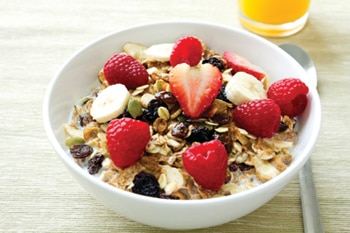 To reach or stay at a healthy weight, how much you eat is just as important as what you eat.
To reach or stay at a healthy weight, how much you eat is just as important as what you eat.What is the difference between a portion and a serving?
A portion is how much food you choose to eat at one time, whether in a restaurant, from a package, or at home. A serving, or serving size, is the amount of food listed on a product’s Nutrition Facts label, or food label (see Figure 1 below).
Different products have different serving sizes. Sizes can be measured in cups, ounces, grams, pieces, slices, or numbers—such as three crackers. Depending on how much you choose to eat, your portion size may or may not match the serving size.
To see how many servings a container has, look at the top of the label. “Servings per container” is listed right above “Serving size.” In the example below, a frozen lasagna serving size is 1 cup. But the container has four servings. If you want to eat 2 cups—or half the package—you’d be eating two servings.
Do a little math to find out how many calories you would really be getting.
- 1 serving = 280 calories
- 2 servings = 280 × 2 = 560 calories
In this case, eating two servings would mean getting twice the calories—and other nutrients—that are listed on the food label.
Figure 1. Nutrition Facts label
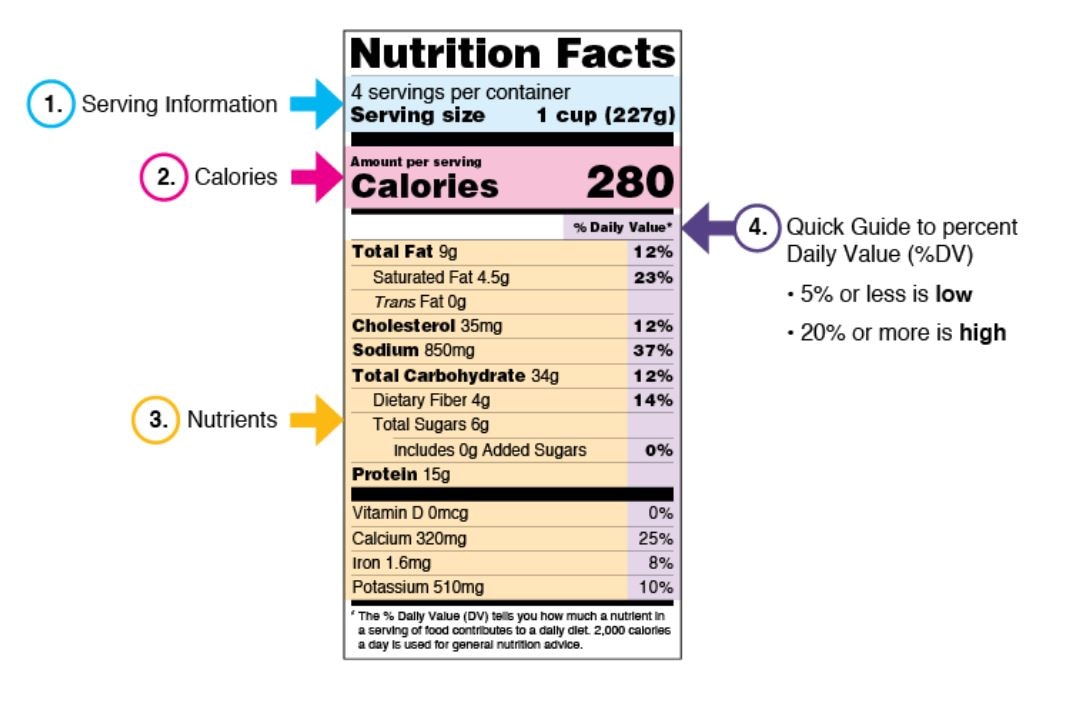
How have recommended serving sizes changed?
The U.S. Food and Drug Administration (FDA) changed some food and beverage serving sizes so the labels more closely match how much we typically eat and drink. As a result of recent updates to the Nutrition Facts label, some serving sizes on food labels may be larger or smaller than they were before (see Figure 2 below). For instance, a serving size of ice cream used to be 1/2 cup. Now it’s 2/3 cup. A serving size of yogurt used to be 8 ounces. Now it’s 6 ounces.
Remember: The serving size on a label is not a recommendation of how much you should eat or drink.
Figure 2. FDA serving size changes
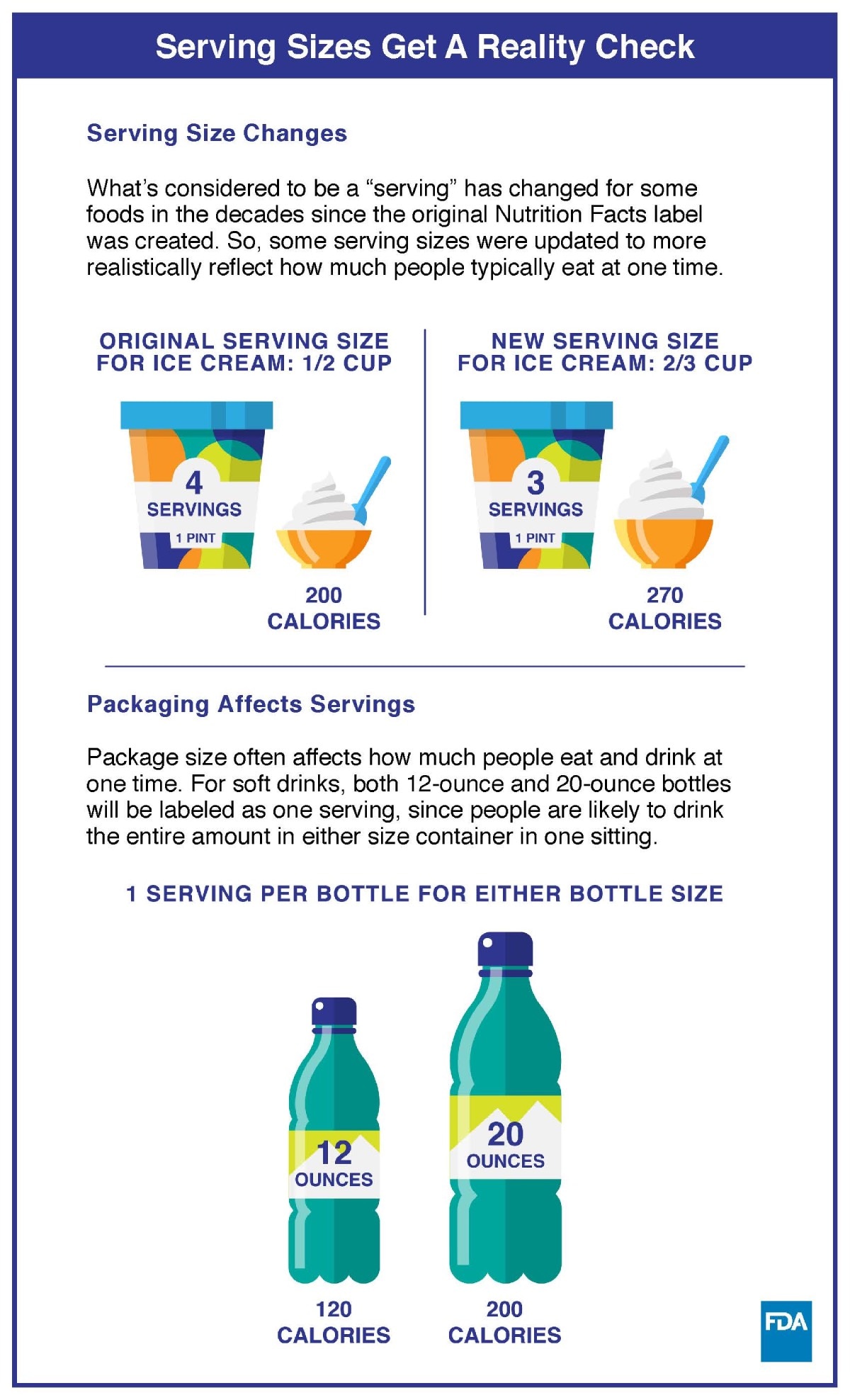
How much should I eat?
The serving size on a food label may be more than or less than the amount you should eat. That’s because how many calories you need each day to maintain your weight or lose weight may depend on
- your age
- your current weight and height
- your metabolism
- whether you’re male or female
- how active you are
For example, if you’re a 150-pound woman whose main physical activity is a short walk once a week, you’ll need fewer calories than a woman about your size who engages in intense physical activity, such as running, several times a week.
To help you figure out how many calories are just enough for you, check out the following resources.
- The Dietary Guidelines for Americans, 2020–2025 can give you an idea of how many calories you may need each day based on your age, sex, and physical activity level.
- The Body Weight Planner tool helps you make your own calorie and physical activity plans to reach and maintain your goal weight.
- The MyPlate Plan helps you form a healthy eating plan with the amounts of food and beverages that are right for you.
 How many calories you need each day depends on your age, weight, metabolism, sex, and physical activity level.
How many calories you need each day depends on your age, weight, metabolism, sex, and physical activity level.How can the Nutrition Facts food label help me?
The FDA’s Nutrition Facts food label is printed on most packaged foods. The food label tells you how many calories and how much fat, protein, carbohydrates, and other nutrients are in one food serving. Many packaged foods contain more than a single serving. The updated food label lists the number of calories in one serving size using larger print than before, so it is easier to read.
Other helpful facts on the food label
The food label has other useful information about what is in one food serving, such as
- total fat. For example, one serving of the food item shown in Figure 3 below has 1 gram of saturated fat and 0 grams of trans fat.
- added sugars. The Dietary Guidelines for Americans, 2020–2025 recommends that less than 10% of your total daily calories should come from added sugars.
- sodium. The Dietary Guidelines for Americans, 2020–2025 recommends limiting sodium to 2,300 milligrams per day, or even less for children younger than age 14.
- other nutrients. Americans don’t always get enough vitamin D and potassium. That’s why the updated food label in Figure 3 includes serving information for both these nutrients. Because most Americans generally do get enough vitamin A and vitamin C, these nutrients are no longer included on the food label. However, food makers may include them if they choose.
Figure 3. Side-by-side comparison of original and new Nutrition Facts labels
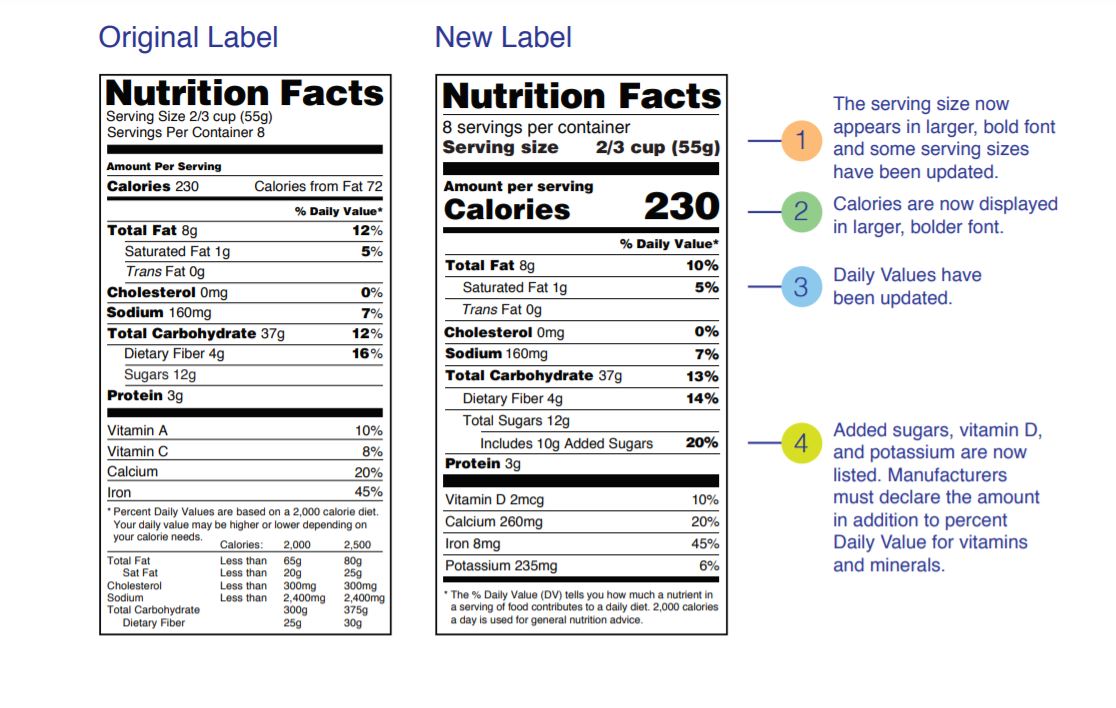
Another way to use the Nutrition Facts label
One way to become healthier now and in the future is to use the Nutrition Facts label together with the MyPlate Plan that helps you figure out how many calories you need each day. Using the two together, as shown in Figure 4 below, can help you figure out how many vegetables, fruits, grains, protein foods, and dairy products your body needs.
Figure 4. Nutrition Facts label and MyPlate.gov
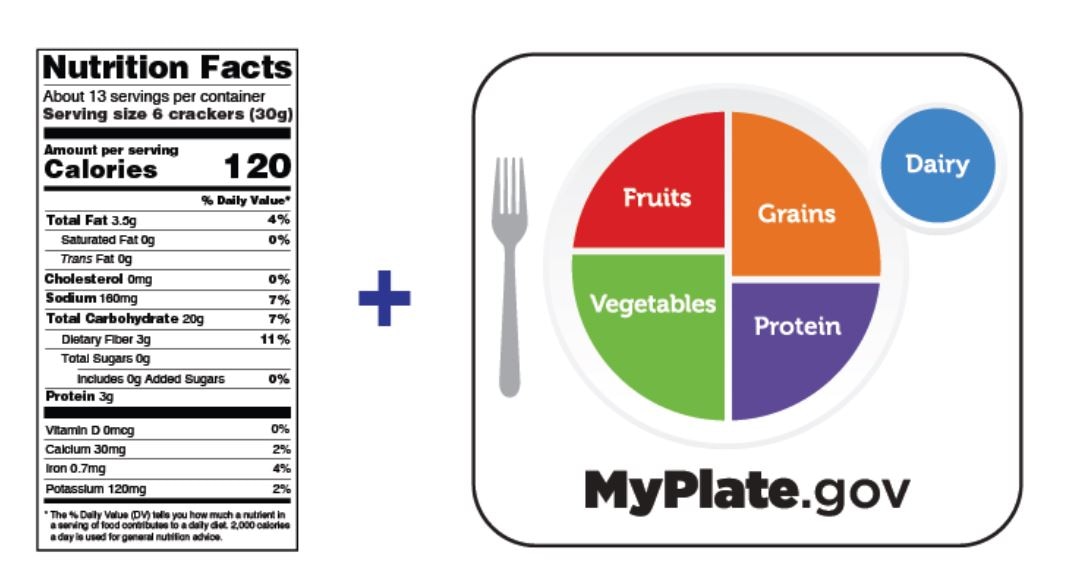
How can I keep track of how much I eat?
Checking food labels for calories per serving is one step toward managing your food portions. It’s also important to keep track of
- what you eat
- when you eat
- where you eat
- why you eat
- how much you eat
Create a food tracker on your cellphone, calendar, or computer to record the information. Or you can download apps available for mobile devices to help you track how much you eat—and how much physical activity you get—each day. For example, the Start Simple with MyPlate app tells you how to get started and is free to download and use.
The sample food tracker in Figure 5 below shows what a 1-day page of a food tracker might look like. In the example, the person chose fairly healthy portions for breakfast and lunch to satisfy hunger. The person also ate five cookies in the afternoon out of boredom rather than hunger.
By 8 p.m., the person was very hungry and ate large portions of high-fat, high-calorie food at a social event. An early evening snack of a piece of fruit and 4 ounces of fat-free or low-fat yogurt might have prevented overeating less healthy food later. The number of calories for the day totaled 2,916—more than most people need. Taking in too many calories may lead to weight gain over time.
Figure 5. Sample food tracker
Thursday
| Time | Food | Amount | Estimated Calories | Place | Hunger/Reason |
|---|---|---|---|---|---|
| 8 a.m. | Coffee, Black | 6 fl. oz. | 2 | Home | Slightly hungry |
| Banana | 1 medium | 105 | |||
| Low-fat yogurt | 1 cup | 250 | |||
| 1 p.m. | Grilled cheese sandwich | 281 | Work | Hungry | |
| Apple | 1 medium | 72 | |||
| Potato chips | Single-serving bag, 1 ounce | 152 | |||
| Water | 16 fl. oz. | 0 | |||
| 3 p.m. | Chocolate-chip cookies | 5 medium-sized | 345 | Work | Not hungry/bored |
| 8 p.m. | Mini chicken drumsticks with hot pepper sauce | 4 | 312 | Restaurant, while out with friends | Very hungry |
| Taco salad | 3 cups in fried flour tortilla with beans and cheese | 586 | |||
| Chocolate cheesecake | 1 piece, 1/12 of 9-inch cake | 479 | |||
| Soft drink | 12 fl. oz. | 136 | |||
| Latte | Espresso coffee with whole milk, 16 ounces | 196 | |||
| Total Calories = | 2,916 | ||||
If you find that you eat even when you’re not hungry, like the person in the food tracker example, try distracting yourself from food by doing something else instead. For instance,
- call or visit a friend
- if at work, take a break and walk around the block, if your work and schedule permit
- try a healthier option, such as a piece of fruit, a handful of nuts, or carrot sticks and hummus
Using your tracker, you may become aware of when and why you consume less healthy foods and drinks. This information may help you make different choices in the future.
How can I manage food portions at home?
You don’t need to measure and count everything you eat or drink for the rest of your life. You may only want to do so long enough to learn typical serving and portion sizes. Try these tips to control portions at home.
- Take one serving according to the food label and eat it off a plate instead of straight out of the box or bag.
- Avoid eating in front of the TV, while driving or walking, or while you are busy with other activities.
- Focus on what you are eating, chew your food well, and fully enjoy the smell and taste of your food.
- Eat slowly so your brain has time to realize your stomach is full, which may take at least 15 minutes.
- Use smaller dishes, bowls, and glasses so you eat and drink less.
- Eat fewer high-fat, high-calorie foods, such as desserts, chips, sauces, and prepackaged snacks.
- Freeze food you won’t serve or eat right away if you make too much. That way, you won’t be tempted to finish the whole batch. If you freeze leftovers in single- or family-sized servings, you’ll have ready-made meals for another day.
- Eat meals at regular times. Delaying meals or skipping meals altogether may cause you to overeat later in the day.
- Buy snacks, such as fruit or single-serving prepackaged foods that are lower in calories. If you buy bigger bags or boxes of snacks, divide the items into single-serving packages right away so you aren’t tempted to overeat.
 A family sharing a meal around a dinner table.
A family sharing a meal around a dinner table.How can I manage portions when eating out?
Although it may be easier to manage your portions when you cook and eat at home, most people eat out from time to time—and some people eat out often. Try these tips to keep your food portions in check when you’re away from home.
- Share a meal with a friend or take half your meal home.
- Avoid all-you-can-eat buffets. Instead, choose restaurants that offer some healthy food choices in controlled portions.
- Order one or two healthy appetizers or side dishes instead of a whole meal. Options include steamed or grilled—instead of fried—seafood or chicken, a salad with dressing on the side, or roasted vegetables.
- Ask to have the basket of bread or chips removed from the table.
- If you have a choice, pick the small-sized—rather than large-sized—drink, salad, or frozen yogurt.
- Look for calorie information next to food and drink items on menus and menu boards to understand how many calories are in a standard restaurant portion.
- Stop eating and drinking when you’re full. Put down your fork and glass. Focus on enjoying the setting and company for the rest of the meal.
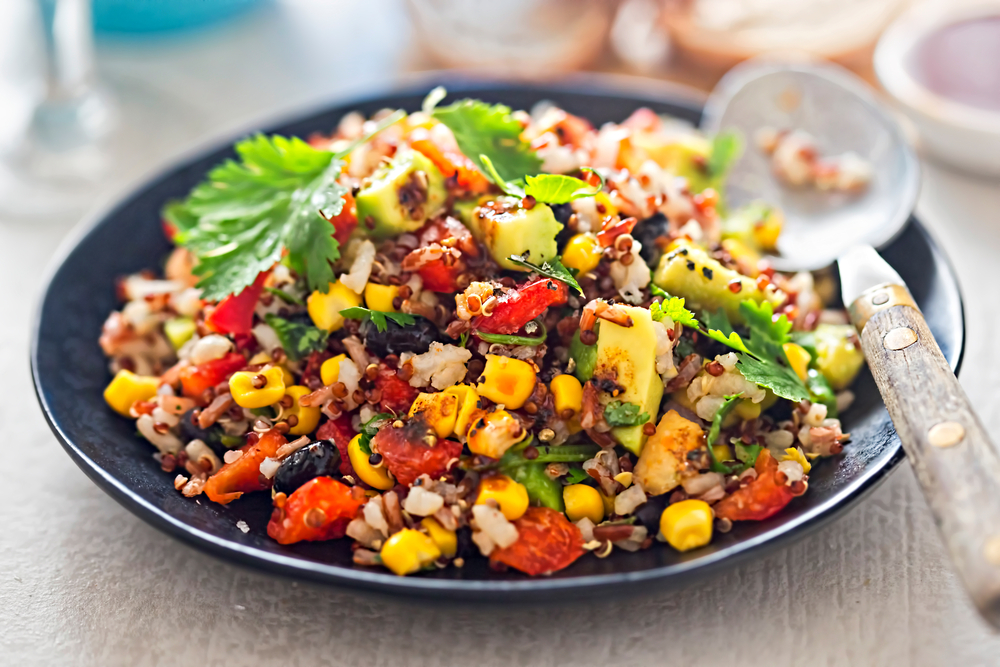 A salad of black beans, avocado, corn, tomato, rice, and quinoa.
A salad of black beans, avocado, corn, tomato, rice, and quinoa.Is getting more food for your money always a good value?
Have you noticed that it costs only a few cents more to get the large fries or soda instead of the regular or small size? Although getting the super-sized meal for a little extra money may seem like a good deal, you end up with more calories than you need for your body to stay healthy. Before you buy your next “value meal combo,” be sure you are making the best choice for your wallet and your health.
How can I manage portions and eat well when money is tight?
Eating healthier doesn’t have to cost a lot of money. For instance,
- Buy fresh fruit and vegetables when they are in season. Check out a local farmers market for fresh, local produce if there is one in your community. Be sure to compare prices, as produce at some farmers markets cost more than the grocery store. Buy only as much as you will use to avoid throwing away spoiled food.
- Match portion sizes to serving sizes. To get the most from the money you spend on packaged foods, try eating no more than the serving sizes listed on food labels. Eating no more than a serving size may also help you better manage your fat, sugar, salt, and calories.
- When eating in a restaurant, ask for meals to be served “family style.” You can order three meals to serve five people, and everyone can taste a portion of each dish.
Clinical Trials for Weight Management
The NIDDK conducts and supports clinical trials in many diseases and conditions, including weight management. The trials look to find new ways to prevent, detect, or treat disease and improve quality of life.
What are clinical trials for weight management?
Clinical trials—and other types of clinical studies—are part of medical research and involve people like you. When you volunteer to take part in a clinical study, you help doctors and researchers learn more about disease and improve health care for people in the future.
Find out if clinical studies are right for you.
Watch a video of NIDDK Director Dr. Griffin P. Rodgers explaining the importance of participating in clinical trials.
What clinical studies for weight management are looking for participants?
You can find clinical studies on weight management at ClinicalTrials.gov. In addition to searching for federally funded studies, you can expand or narrow your search to include clinical studies from industry, universities, and individuals; however, the National Institutes of Health does not review these studies and cannot ensure they are safe. Always talk with your health care provider before you participate in a clinical study.
This content is provided as a service of the National Institute of Diabetes and Digestive and Kidney Diseases
(NIDDK), part of the National Institutes of Health. NIDDK translates and disseminates research findings to increase knowledge and understanding about health and disease among patients, health professionals, and the public. Content produced by NIDDK is carefully reviewed by NIDDK scientists and other experts.
The NIDDK would like to thank:
Carla Miller, Ph.D., R.D., Professor, Ohio State University
